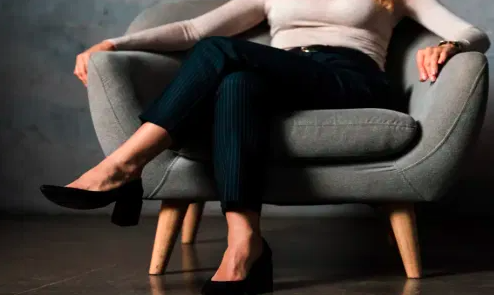You’ve probably noticed it in cafes, meetings, or even on TV—many women sit with their legs crossed. While it might seem like just a comfortable or casual pose, there’s actually a lot more going on beneath the surface.
From cultural customs to subtle psychology, the way a woman sits—especially when she crosses her legs—can say a lot about how she’s feeling, how she wants to be perceived, and what social norms she’s responding to.
More Than Just a Habit: Cultural Roots and Social Expectations
Throughout history, women’s posture has often been a reflection of social norms. In many Western cultures, especially in past centuries, crossing one’s legs was seen as a sign of modesty and grace. Think of old paintings or etiquette guides—it was all about sitting “properly,” often with ankles or legs crossed. This pose projected elegance, delicacy, and femininity.
But this isn’t a one-size-fits-all rule.
In some cultures, especially in parts of Asia and the Middle East, crossing your legs—especially in formal settings—can be seen as disrespectful or overly casual. So while some women grow up seeing this pose as “ladylike,” others may be taught to avoid it altogether.
Psychological Meanings: What Leg Crossing Might Say About You
Psychologists have explored how body language, including how we sit, reflects our inner world. And leg crossing is no exception.
Here’s what it might say:
- Creating a barrier: Crossing legs can create a subtle “wall,” signaling that someone wants a bit of personal space.
- Self-soothing: In awkward or tense situations, the posture might feel protective—like wrapping yourself in a comforting hug.
- Confidence or elegance: On the flip side, when someone sits with one leg confidently draped over the other, it can signal poise and assurance.
- Shyness or reservation: A tight, inward leg cross might suggest nervousness, discomfort, or self-consciousness.
From a psychoanalytic view, closed-off body language (like tightly crossed legs and folded arms) often reflects internal feelings of insecurity or anxiety. Meanwhile, relaxed, open poses typically indicate ease and openness.
Fashion, Media, and the “Unspoken Rules”
Let’s not forget the influence of fashion and pop culture. High heels, short skirts, or fitted clothing often “encourage” leg crossing as a way to maintain modesty or elegance. Over time, this becomes second nature—not just a pose, but a learned behavior reinforced by media and societal expectations.
Add to that the fact that many women have been subtly (or not so subtly) taught from a young age to “sit like a lady,” and you can start to see how this pose becomes a cultural script.
Nonverbal Cues: How It Affects Communication
In social or professional settings, how someone sits can send silent signals. For example:
- Crossed legs + turned away = possibly disengaged or reserved
- Crossed legs + leaning forward = curious but cautious
- Uncrossed, relaxed posture = open and receptive
These subtle cues can influence how others perceive you—sometimes even more than what you say aloud.
Final Thoughts
At the end of the day, crossing your legs might just feel like the most comfortable way to sit. But when we dig a little deeper, it becomes clear that this common gesture is shaped by a fascinating mix of culture, psychology, and social norms.
So next time you sit down and cross your legs—whether out of comfort, habit, or instinct—know that your body might just be saying more than you think.

Sophia Reynolds is a dedicated journalist and a key contributor to Storyoftheday24.com. With a passion for uncovering compelling stories, Sophia Reynolds delivers insightful, well-researched news across various categories. Known for breaking down complex topics into engaging and accessible content, Sophia Reynolds has built a reputation for accuracy and reliability. With years of experience in the media industry, Sophia Reynolds remains committed to providing readers with timely and trustworthy news, making them a respected voice in modern journalism.
